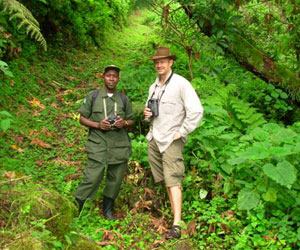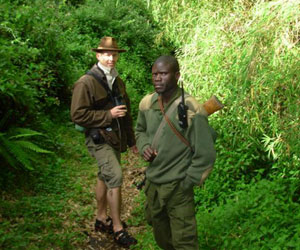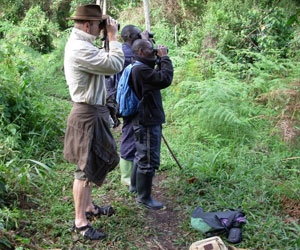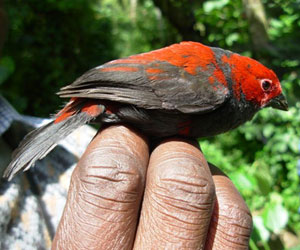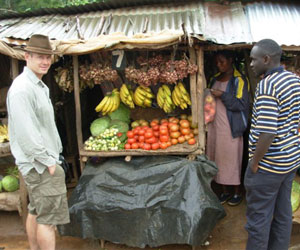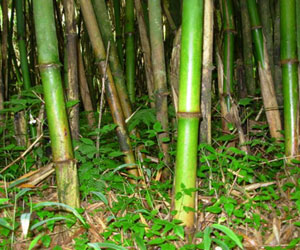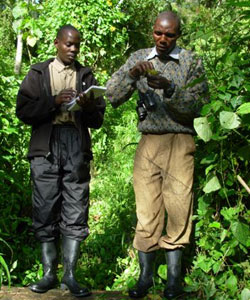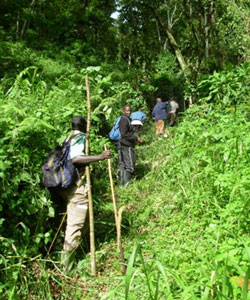|
|
||||||
 |
||||||
|
||||||
R.F.C.G. News
|
Crimsonwing report-back from Simon
Espley The Rare Finch Conservation Group is conducting research into the crimsonwing family of forest finches in the Ruhija section of Bwindi Impenetrable Forest National Park in south-western Uganda. This family of finches has 4 species, of which two (Shelley’s crimsonwing Cryptospiza Shelleyi and dusky crimsonwing Cryptospiza jacksonii) are endemic to the Albertine Rift area (a mountainous area bordering Uganda, Rwanda and DRC) and the remaining two (red-faced crimsonwing Cryptospiza reichenovii and Abyssinian crimsonwing Cryptospiza salvadorii) occur in the Albertine Rift and beyond. Shelleys crimsonwing is described by IUCN in the Red Data List as vulnerable (the species faces a high risk of extinction in the wild) and population numbers are thought to be anything from 2,500 to 10,000 and declining. The bird has not been found in large enough numbers to justify an accurate population estimate. Our questioning amongst field workers, tourism bird guides and conservation officials within the range has revealed no, or at best an alarmingly low rate, of encounters.
The Rare Finch Conservation Group aims to determine the status of the 4 species of crimsonwings (with particular emphasis on Shelley’s), to increase the amount of available scientific knowledge about these finches and to determine and drive a conservation strategy, if necessary.
This project is a joint venture between the Rare Finch Conservation Group www.rarefinch.co.za (originators and coordinators) and Wildlife Conservation Society www.wcs.org (on-site scientific and logistics management).
Simon Espley (Director of Rare Finch Conservation Group) visited the project in December 2007, his third trip to the area. He also explored Mgahinga Gorilla National Park to investigate reports of sightings of Shelley’s crimsonwings. Here is his report:
I spent 2 days in Ruhija visiting our project. The area is very densely vegetated with countless steep valleys. Weather is tropical but with frequent low temperatures (2,500 meters above sea level). The Ruhija area is not frequented by many tourists – they tend to go to the Bohoma area to trek for gorillas. There are gorillas in Ruhija and we did hear them nearby during one of our walks.
We have a team of 5 men who are managing a mist-netting operation in the area surrounding the Institute for Tropical Forest Conservation, near the Ndego Gate of Ruhija. I have gps co-ordinates, tracks and waypoints if anybody is interested. Andrew Ocama (project leader) spends most of his time in Kampala but does visit the project every month for about a week. This effectively leaves Benson Bamutura in charge of operations for much of the time. Benson is a fountain of energy and a very good bird guide who has plenty of experience of netting and record-keeping. The team sets up about 10 nets in the morning at first light and visits the nets every half hour. Captured birds are noted in a register before release as soon as possible, and for crimsonwings they ring the birds and take detailed measurements. From now onwards they will photograph the birds as well. The nets are dismantled late morning once it gets too hot. We did capture a dusky crimsonwing while I was there (see photograph) as well as many other birds. They have captured 9 dusky and 2 red-faced crimsonwings so far. We also hiked to a few additional Ruhija areas to find suitable crimsonwing habitat. Early 2008 will see the nets moved to these areas, including the “bamboo zone” – an area of extensive dense bamboo thickets (favored habitat for Shelley’s crimsonwing).
The trapping in Ruhija will continue for the first half of 2008, following which Andrew will write up a full report. The fact that we have not yet trapped or even seen any Shelley’s crimsonwings confirms how rare this bird is. I questioned park officials and bird guides at every opportunity and the reality is that Shelley’s is very seldom seen and has assumed an almost mythical status. Benson, our main man on the ground, has seen the bird 3 times in his life – in Mgahinga Gorilla National Park. There is a very good chance that this first phase of our project in Ruhija will produce no Shelley’s. Having said that, our strategy is developing and we will adjust for phase two to increase our chances of success. The fact that we have trapped 2 other crimsonwing species means that we are on the right track.
I left Ruhija appreciating the enormity of our task (to trap a bird that is seldom seen) and also understanding the logistical issues that we face in these remote and thickly vegetated areas. I also felt very satisfied that our project has employed and educated local people and excited that we are pioneering research on a finch family that is not well understood. I have a good feel for how we should adjust our strategy for the second phase, but would rather expand on that after further discussion with Andrew and our team. I am now in email and cell phone contact with Andrew and Benson.
The second half of my trip was spent looking for Shelley’s crimsonwings in Mgahinga Gorilla National Park, a long and slow drive south of Ruhija. My base was very close to the DRC and Rwandan borders, in south-west Uganda. Andrew, Benson and I went on long walks each morning with Sunday Ndayakunze, our local bird guide. Sunday has seen Shelley’s 3 times in 15 years of bird guiding. He says that you stand a greater chance of seeing Shelley’s if you locate and watch dusky crimsonwings, because they tend to move around together. We adopted this strategy and saw many dusky crimsonwings but no Shelley’s. The area in Mgahinga known for Shelley’s is called Sabyinyo Gorge, a beautiful area about 1 hour’s hard walk from the base camp. I can see why this area is good Shelley’s habitat – the forest is bordered by very thickly vegetated bamboo thickets and dense undergrowth. We spent 3 days in this gorge, although on one morning we walked an alternative area because a family herd of forest elephant had taken control of Sabyinyo.
I left Mgahinga convinced that the Mgahinga area is good for Shelley’s, although it will be tough to see, let along trap. Trapping will involve more logistical issues than Ruhija as the area is very remote and the trapping sites are at least one hour’s hard hiking from the base camp. I have heard of a team successfully trapping Shelley’s in the Rwenzories area of Uganda many years ago as part of a larger project, and am in the process of investigating this report. This area is even more remote than Mgahinga. I will discuss these options in more detail with our team as we conclude our program in Ruhija. Whichever area we select next, I am convinced that persistence will see us finding Shelley’s crimsonwings and developing a better understanding of the issues facing this rare bird. It is intriguing that both Shelley’s and Dusky are endemic to this area and both occur in the same habitat and yet Shelley’s is far more threatened, with suspected diminishing populations.
Uganda’s south-west corner is an incredibly beautiful part of the world and well worth visiting for those of you with an adventurous spirit. For those interested in bird-watching this area is part of the Albertine Rift and is jammed with endemic species. I will be going back in mid or late 2008 when we role out phase 2.
Simon Espley Director, Rare Finch Conservation Group.
Please keep an eye on our web site www.rarefinch.co.za
|
Contact Rare Finch Conservation Group
e-mail: editor@avitalk.co.za | postal:
P.O.Box 782403, Sandton, 2146, South Africa
Copyright © 2006-2025 Rare Finch Conservation
Group in all materials not expressly attributed to another. All rights reserved.
Web Development www.simplywebs.co.za
